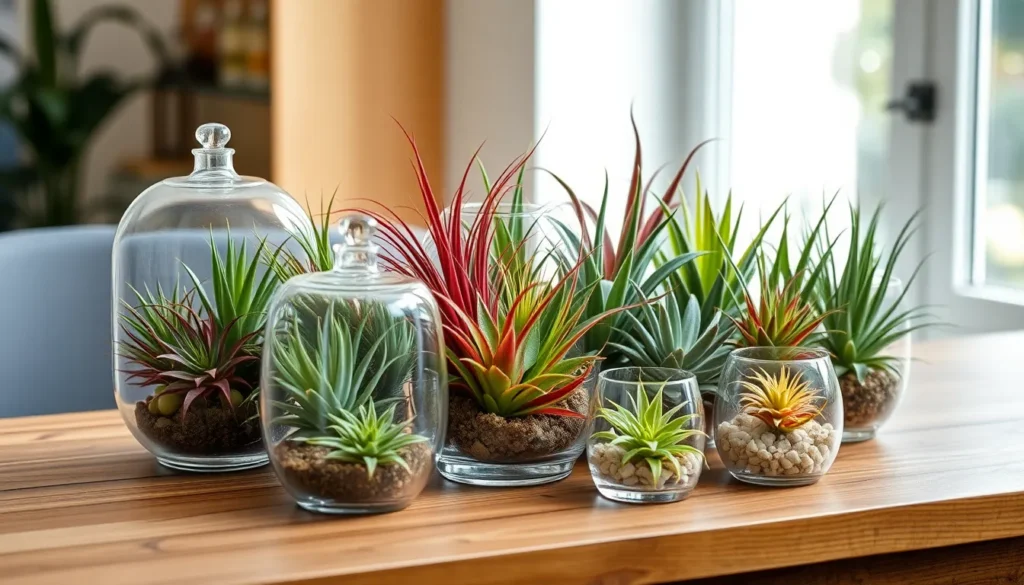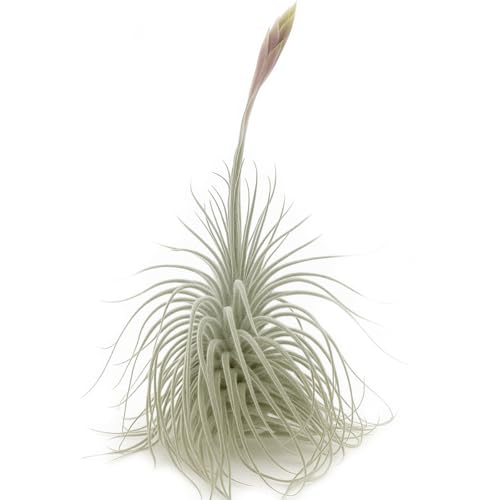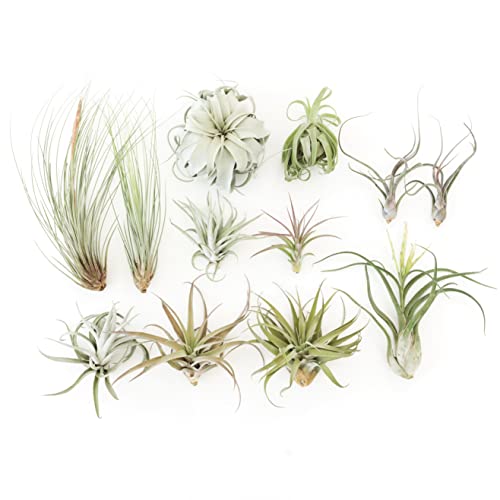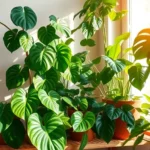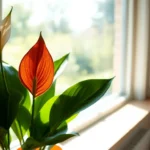Air plants have taken the houseplant industry by storm and it’s easy to see why. These fascinating Tillandsia species don’t need soil to thrive – they literally live on air! We’ve watched countless plant enthusiasts fall in love with these low-maintenance beauties that seem almost magical in their simplicity.
What makes air plants so appealing isn’t just their unique growing habits. They’re incredibly versatile decorative elements that transform any space into a modern botanical showcase. Whether you’re hanging them in glass terrariums or mounting them on driftwood we guarantee they’ll become conversation starters in your home.
But here’s the thing – while air plants are relatively easy to care for they do have exact needs that many beginners overlook. We’ve seen too many beautiful air plants wither away because their owners didn’t understand the basics. That’s exactly why we’ve created this comprehensive guide to help you master air plant care and keep these stunning specimens thriving for years to come.
What Are Air Plants and Why Choose Them
Air plants belong to the Tillandsia genus and represent over 500 epiphytic species that naturally grow on other plants without parasitizing them. These remarkable plants absorb moisture and nutrients directly through specialized scales called trichomes on their leaves rather than traditional root systems.
Epiphytes thrive in their natural habitats across Central America, South America, and the southern United States by clinging to tree branches, rocks, and other surfaces. Their roots serve primarily as anchors instead of nutrient absorption systems like conventional houseplants.
Air plants offer distinct advantages for modern plant enthusiasts:
- Soil free growing eliminates messy potting requirements and reduces pest problems
- Flexible placement options allow mounting on walls, hanging from ceilings, or displaying in terrariums
- Minimal space requirements make them perfect for apartments and small living areas
- Low maintenance schedules require watering only 1-2 times per week
- Drought tolerance helps them survive neglect better than traditional houseplants
Three primary categories define air plant varieties based on their appearance and care needs. Mesic air plants feature green, soft leaves and prefer higher humidity levels between 50-60%. Xeric air plants display silvery, fuzzy foliage and tolerate lower humidity around 30-40%. Intermediate varieties combine characteristics from both categories and adapt to moderate humidity levels.
Popular beginner friendly species include Tillandsia ionantha with its compact purple blooms, Tillandsia xerographica known for its large silvery rosette formation, and Tillandsia caput medusae featuring distinctive curly tentacle like leaves. Each species brings unique visual appeal while maintaining relatively simple care requirements.
Air plants reproduce through offset production where smaller plants develop at the base of mature specimens after flowering. This natural propagation method allows collectors to expand their collections without purchasing additional plants.
Materials Needed for Air Plant Care
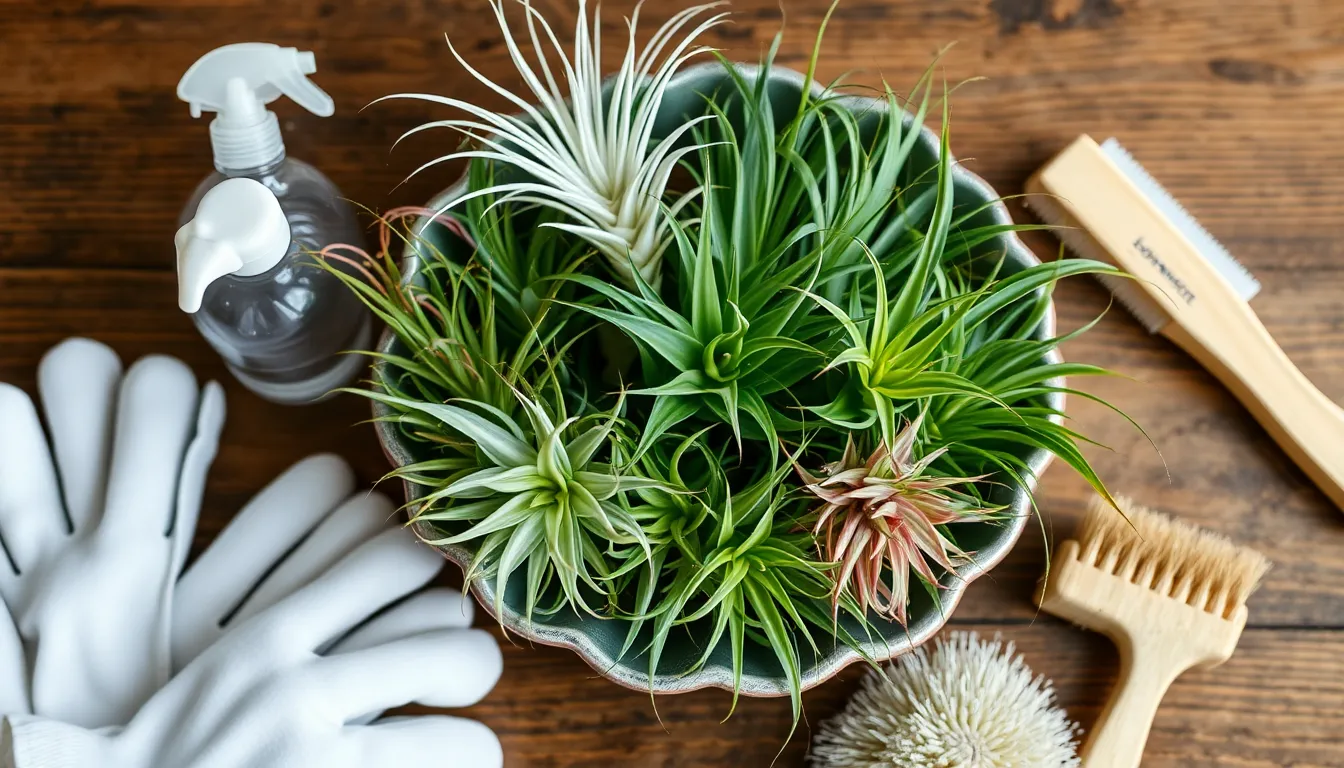
Successful air plant care depends on having the right materials to create optimal growing conditions for these unique epiphytes. We outline the essential items that support healthy Tillandsia growth and maintenance.
Water Selection and Sources
Quality water forms the foundation of effective air plant care. Tap water works well for most air plants when it contains minimal chemicals and moderate mineral content. Pond water provides natural nutrients that many Tillandsia species appreciate. Aquarium water offers balanced mineral content without harmful additives.
Rainwater delivers the most natural hydration option for air plants since it mimics their native environment. Bottled spring water serves as a reliable alternative when natural water sources remain unavailable. Distilled water and artificially softened water damage air plants by lacking essential minerals these epiphytes require.
Watering Equipment
Plant misters and spray bottles enable precise moisture delivery to air plant leaves and specialized scales. Fine mist settings distribute water evenly across plant surfaces without overwhelming delicate tissues. Multiple spray bottles allow us to prepare different water types for various plant species.
Large bowls or clean sinks accommodate soaking sessions that provide deep hydration for air plants. Container size must allow plants to float freely without crowding. Deep vessels prevent plant damage during submersion periods.
Fertilization Supplies
Diluted liquid fertilizers formulated specifically for air plants or bromeliads provide essential nutrients without chemical burn. Bromeliad fertilizers contain appropriate nitrogen ratios that support Tillandsia growth patterns. Standard houseplant fertilizers require dilution to 25% strength before application.
Monthly feeding schedules during spring and summer optimize nutrient uptake when plants show active growth. Winter fertilization reduces to quarterly applications as plant metabolism slows.
Handling Equipment
Cotton gloves or soft microfiber cloths protect delicate air plant structures during maintenance tasks. Gentle handling prevents damage to specialized leaf scales that absorb moisture and nutrients. Clean tools reduce contamination risks that compromise plant health.
Soft brushes remove dust accumulation from plant surfaces without scratching protective leaf coatings. Small tweezers extract dead plant material from tight spaces between leaves.
Choosing the Right Air Plant Varieties
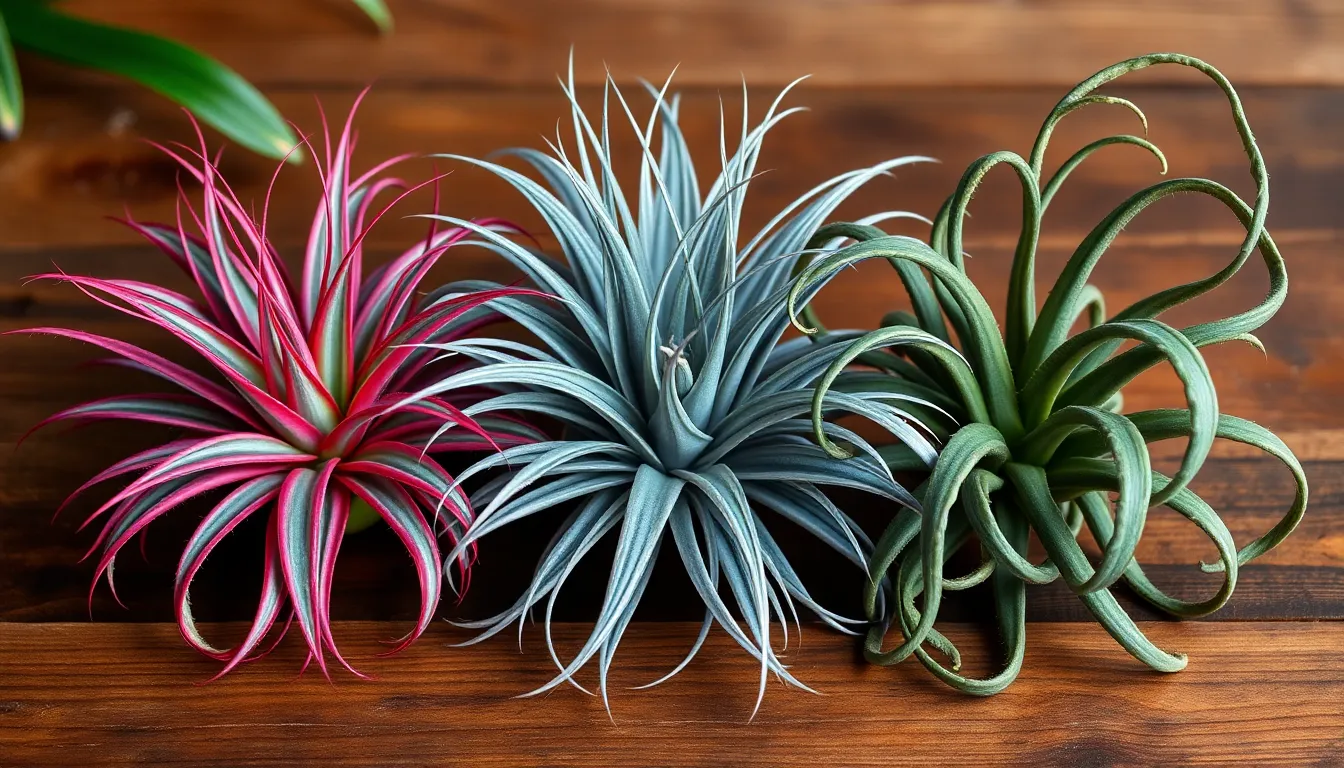
Selecting appropriate air plant varieties depends on your experience level and display preferences. We examine three popular Tillandsia species that offer distinct characteristics and proven success rates for home cultivation.
Tillandsia Ionantha
Tillandsia Ionantha stands out as the ideal beginner air plant due to its compact size and vibrant color transformations. This variety reaches 2-3 inches in height and displays green foliage that transforms to brilliant red or pink during blooming periods.
Care requirements remain minimal for Ionantha varieties. Bright indirect light exposure for 6-8 hours daily promotes healthy growth patterns. Weekly soaking sessions of 5-10 minutes provide adequate hydration without overwatering risks.
Temperature tolerance ranges from 10°C to 32°C make this species adaptable to most indoor environments. Purple tubular flowers emerge from colorful bracts during maturity phases. Multiple cultivars exist including Ionantha Fuego with intense red coloration and Ionantha Rubra featuring deeper burgundy tones.
Tillandsia Xerographica
Tillandsia Xerographica commands attention as the largest air plant variety with dramatic silver-gray foliage reaching 12-18 inches in diameter. This species originates from Central American regions and develops striking rosette formations with thick succulent-like leaves.
Watering frequency decreases to every 2-3 weeks for Xerographica specimens due to their drought-adapted nature. Extended soaking periods of 15-20 minutes accommodate their substantial leaf mass. Air circulation becomes critical after watering sessions to prevent moisture retention in dense leaf arrangements.
Growth rates progress slowly over 5-7 years before reaching full maturity. Yellow flower spikes emerge from mature plants and can extend 3-4 feet in height. Display options include hanging installations or table centerpieces where their architectural form creates focal points.
Tillandsia Caput-Medusae
Tillandsia Caput-Medusae features distinctive serpentine leaf structures that curve and twist in flowing patterns resembling mythological imagery. This medium-sized variety grows 6-8 inches tall with hollow bulbous bases that store moisture reserves.
Specialized leaf formations require modified care approaches compared to flat-leafed varieties. Gentle misting 2-3 times weekly prevents water accumulation in tight leaf spaces. Bright filtered light enhances the natural silvery coloration while preventing leaf burn on delicate surfaces.
Flowering produces red and purple tubular blooms extending above the twisted foliage. Multiple offsets develop around the base after blooming cycles complete. Mounting options include cork bark or driftwood surfaces that complement the plant’s natural epiphytic growth habits.
Setting Up the Perfect Environment for Air Plants
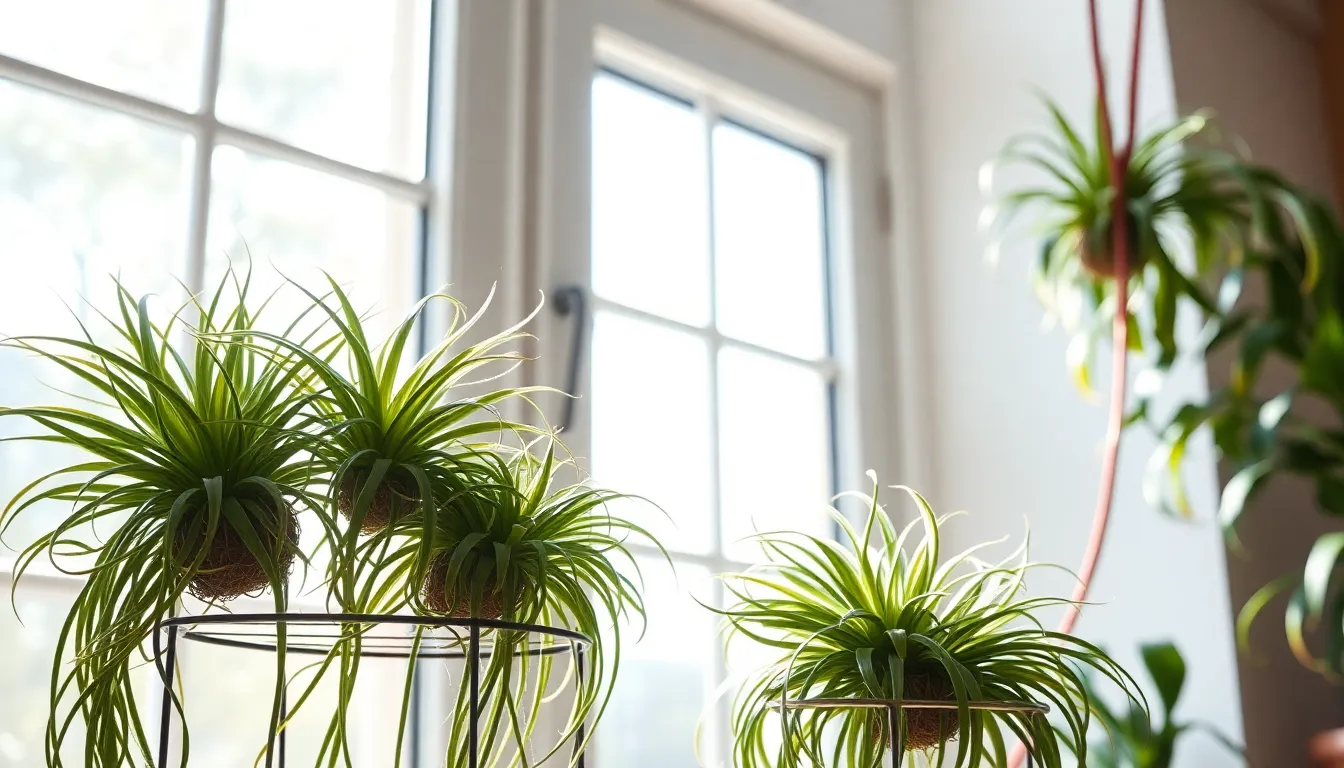
Creating optimal growing conditions ensures your air plants flourish and develop their characteristic vibrant colors. Environmental factors directly impact plant health and determine long-term success rates.
Light Requirements
Air plants thrive in bright, indirect sunlight that mimics their natural forest canopy habitat. Position plants 3-6 feet from south-facing windows to provide consistent illumination without heat damage. Direct sunlight exposure becomes beneficial when limited to 2-3 hours during morning or late afternoon periods.
Full-spectrum fluorescent lighting serves as an excellent alternative for indoor spaces lacking adequate natural light. Place fluorescent fixtures 6-12 inches above plants and maintain 12-14 hour daily exposure cycles. LED grow lights work effectively when positioned 12-18 inches away and operated for 10-12 hours daily.
Monitor leaf color changes to assess lighting adequacy. Healthy air plants display vibrant green hues with silver trichomes, while pale or stretched growth indicates insufficient light exposure. Conversely, brown or reddish leaf tips signal excessive direct sunlight that requires immediate adjustment.
Temperature and Humidity Considerations
Air plants prefer warm temperatures between 50°F and 90°F (10°C to 32°C) for optimal metabolic function. Maintain consistent temperatures above 45°F to prevent cellular damage and growth stunting. Indoor environments typically provide suitable temperature ranges year-round without additional heating requirements.
Humidity levels directly affect watering frequency and plant vitality. Air plants adapt to humidity ranges from 40-60% found in most homes. More frequent misting becomes necessary when indoor air remains dry below 40% humidity, particularly during winter heating seasons.
Temperature fluctuations stress air plants when exceeding 15°F variations within 24-hour periods. Avoid placing plants near heating vents, air conditioning units, or drafty windows that create extreme temperature swings. Gradual seasonal changes pose no problems for healthy established plants.
Air Circulation Needs
Good air circulation prevents moisture accumulation that leads to bacterial and fungal infections. Position air plants in areas with gentle air movement from fans, open windows, or natural convection currents. Stagnant air environments increase rot risk by 300% compared to well-ventilated spaces.
Air plants dry completely within 3 hours after watering when proper ventilation exists. Test drying rates by monitoring plant moisture levels post-soaking. Insufficient airflow extends drying times beyond 4 hours and creates dangerous conditions for root and leaf rot development.
Enclosed containers trap moisture and eliminate essential air exchange that air plants require for survival. Display plants on open surfaces like wire stands, driftwood pieces, or hanging installations that promote 360-degree air circulation. Commercial terrariums work only when featuring multiple ventilation openings and regular air exchange systems.
How to Water Your Air Plants Properly
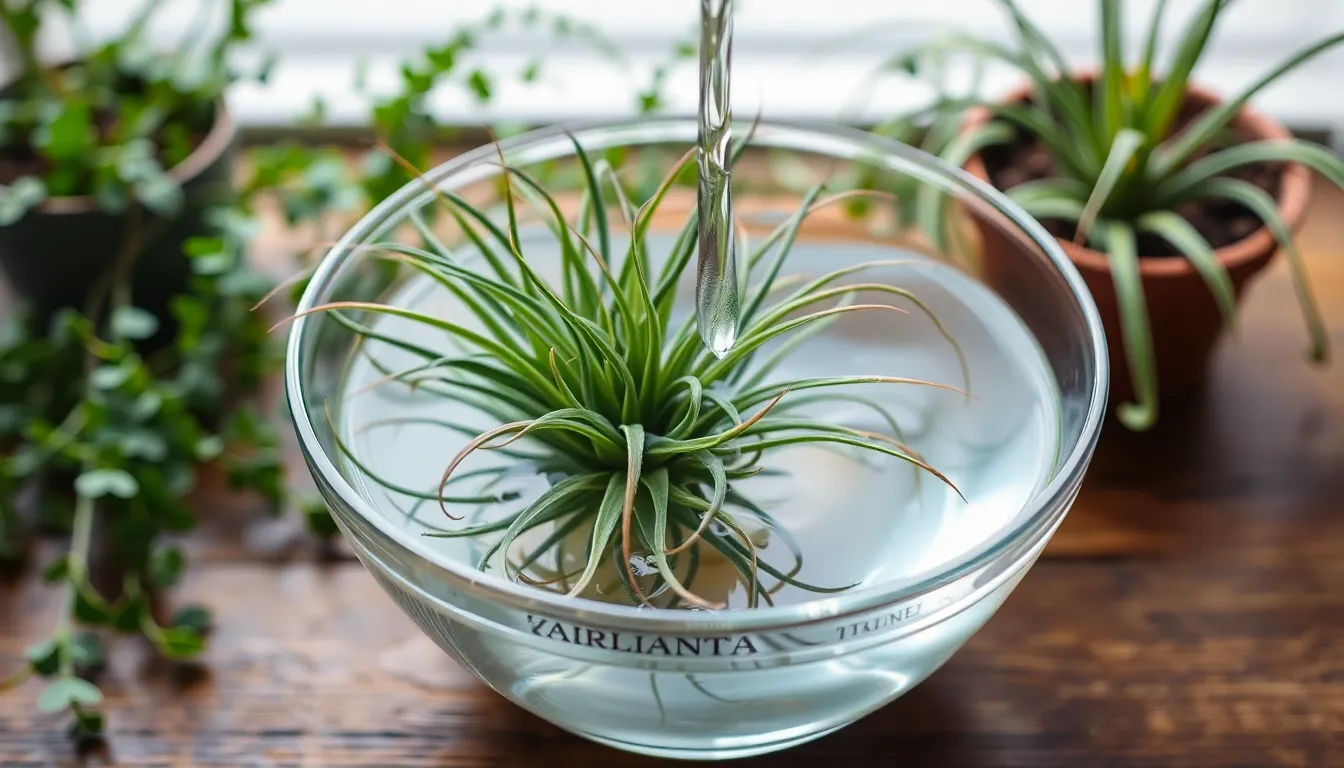
Proper watering techniques form the foundation of successful air plant care. Understanding the correct methods prevents common mistakes that lead to plant decline.
The Soaking Method
Submerging your entire air plant in water provides the most thorough hydration for these epiphytic plants. Fill a bowl or container with room temperature water and completely immerse your Tillandsia for 20 to 30 minutes for routine watering or extend the duration to 1 to 2 hours for plants showing signs of dehydration.
Remove the plant from the water and gently shake off excess moisture to prevent water from pooling in the center of the plant. Turn the plant upside down and give it several gentle shakes to ensure water drains from between the leaves. Place the air plant in a location with good air circulation to dry completely within 4 hours.
Avoid leaving water trapped in the crown or leaf joints as this creates conditions for bacterial rot and fungal infections. Check that all water has drained before returning the plant to its display location.
The Misting Method
Spraying water directly onto the leaves using a plant mister maintains humidity levels between soaking sessions. Hold the mister 6 to 8 inches away from the plant and apply 2 to 3 light sprays covering all leaf surfaces evenly.
Focus the misting on the underside of leaves where the specialized scales absorb moisture most effectively. Mist your air plants once weekly plus to regular soaking to provide consistent hydration in dry indoor environments.
This method works particularly well for maintaining moisture during winter months when indoor heating systems reduce ambient humidity levels below the optimal 40 to 60 percent range.
Signs Your Air Plant Needs Water
Leaves folding inward or curling indicate your air plant requires immediate watering attention. Healthy air plants display leaves that extend outward from the center in their natural growth pattern.
Observe the leaf tips for browning or crispy texture which signals prolonged dehydration stress. The plant’s overall appearance becomes dull or lackluster when moisture levels drop below acceptable thresholds.
Tightly closed leaf formations represent the plant’s natural response to conserve remaining moisture during drought conditions. These visual cues appear 1 to 2 days before the plant reaches critical dehydration levels.
How Often to Water Different Varieties
Water frequency varies based on species type and environmental conditions affecting your exact growing situation. Most air plants require watering every 1 to 2 weeks under typical indoor conditions with moderate humidity and temperature.
Xeric varieties with thick, silvery leaves need less frequent watering due to their natural drought adaptations, requiring water every 10 to 14 days. Mesic varieties with thinner, greener foliage demand more consistent moisture and benefit from watering every 7 to 10 days.
Summer and early fall conditions increase watering frequency to weekly intervals due to higher temperatures and lower humidity levels. Winter and spring seasons allow for extended periods between watering sessions every 10 to 14 days when cooler temperatures and increased humidity reduce evaporation rates.
Environmental factors such as air conditioning, heating systems, and geographic location directly impact watering schedules requiring adjustments based on your exact conditions.
Feeding Your Air Plants
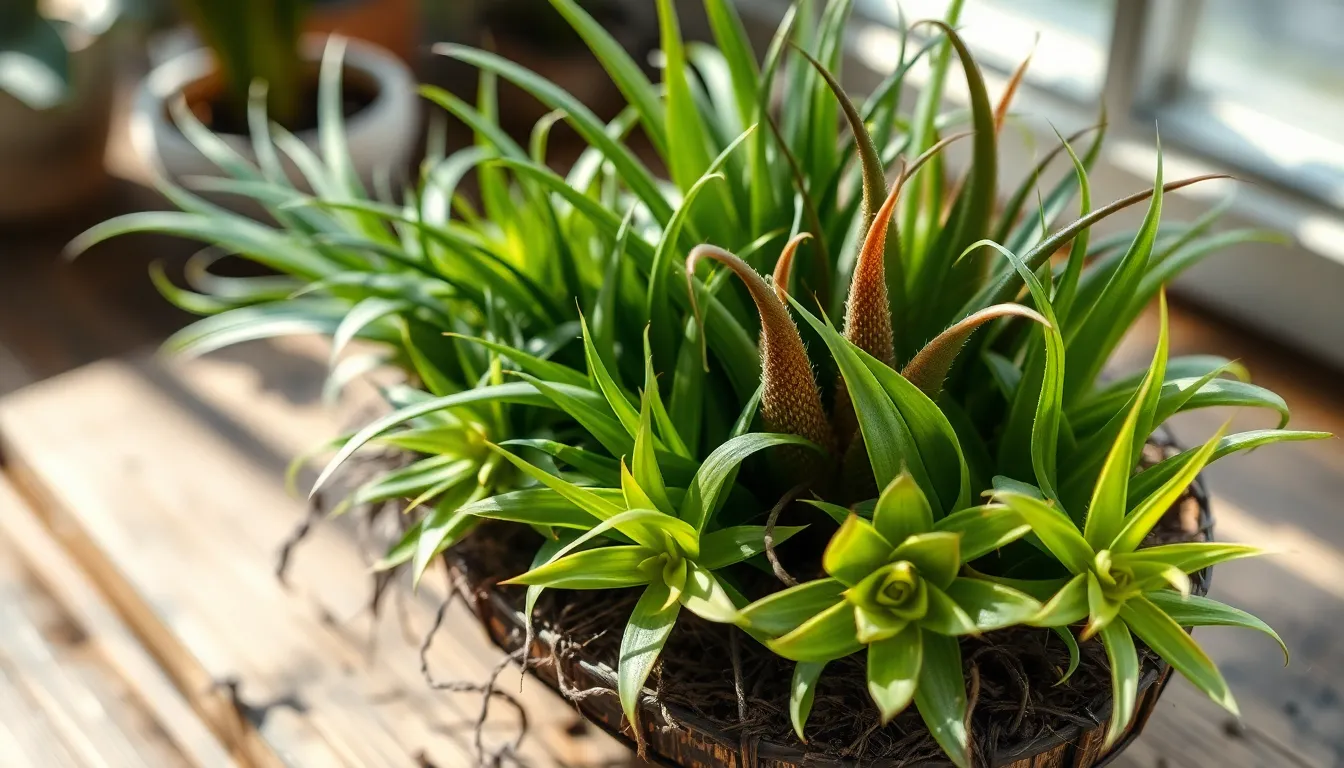
Air plants absorb nutrients from the air and water around them through specialized leaf scales rather than traditional root systems. Supplemental fertilization enhances their growth and maintains their vibrant appearance throughout active growing seasons.
Choosing the Right Fertilizer
Diluted liquid fertilizers designed specifically for air plants or bromeliads provide optimal nutrition without damaging delicate leaf structures. Standard houseplant fertilizers contain excessive nitrogen concentrations that burn air plant foliage and disrupt their natural nutrient absorption processes.
Bromeliad fertilizers offer balanced nutrient ratios that match air plant requirements perfectly. These specialized formulations contain reduced nitrogen levels and appropriate phosphorus and potassium concentrations for epiphytic plants. Orchid fertilizers serve as acceptable alternatives when bromeliad-exact options remain unavailable.
Avoid fertilizers containing copper or boron compounds since these elements prove toxic to Tillandsia species. Water-soluble powder fertilizers work effectively when mixed according to manufacturer specifications and diluted to quarter strength for air plant applications.
Application Methods and Frequency
Spray diluted fertilizer directly onto leaves during regular misting sessions or add the solution to soaking water for comprehensive nutrient distribution. Both methods ensure even coverage across all leaf surfaces where absorption occurs most efficiently.
Misting application allows precise control over fertilizer distribution and works best for mounted displays or hanging arrangements. Mixing fertilizer into soaking water provides thorough saturation and benefits plants requiring deep hydration cycles.
Apply fertilizer once monthly during spring and summer seasons when air plants demonstrate active growth patterns. Growth rates slow significantly during fall and winter months, reducing nutrient requirements and fertilizer frequency to every 6-8 weeks.
| Season | Frequency | Method |
|---|---|---|
| Spring | Monthly | Misting or soaking |
| Summer | Monthly | Misting or soaking |
| Fall | Every 6 weeks | Reduced concentration |
| Winter | Every 8 weeks | Reduced concentration |
Dilute fertilizer to 25% of recommended strength for regular houseplants to prevent nutrient burn and salt buildup on leaf surfaces. Excessive fertilization causes brown leaf tips and stunted growth patterns that compromise plant health over extended periods.
Creative Display Ideas for Air Plants
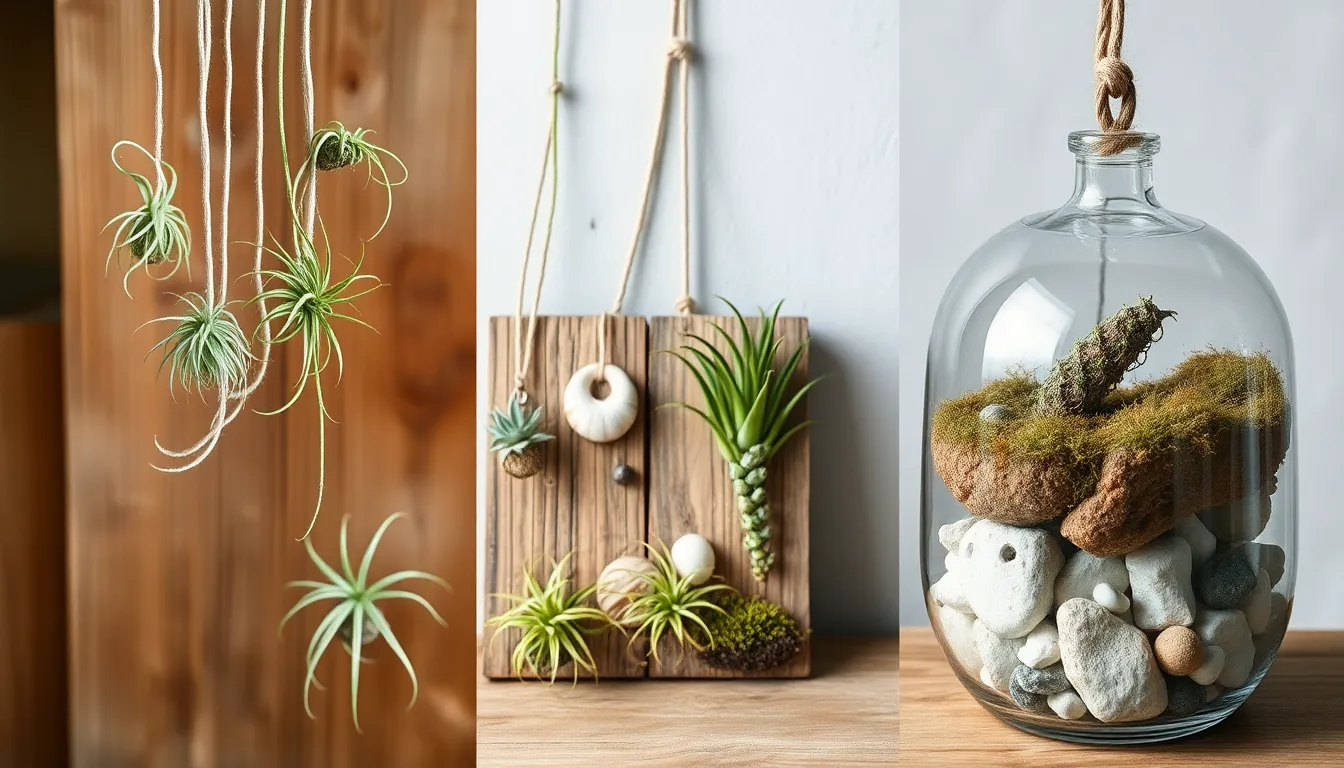
Air plants offer unmatched versatility for decorative arrangements throughout your home. Their soil-free nature opens up countless display possibilities that traditional plants cannot achieve.
Hanging Displays
Wire or string suspended air plants create visually striking mobile displays that capture attention from every angle. Attach individual plants to thin gauge wire and hang them at varying heights from ceiling hooks to form ever-changing aerial gardens. Wooden dowels and natural branches provide rustic alternatives that complement the organic nature of Tillandsia species.
Frame-mounted displays work exceptionally well in modern interiors where clean lines matter most. Position multiple air plants along a geometric wire frame to create sculptural elements that double as living art. Macrame holders add textural interest while allowing plants to receive optimal air circulation from all directions.
Height variations enhance the visual impact of hanging arrangements significantly. Suspend 3 to 5 air plants at different levels to create depth and movement within your display space.
Mounted Arrangements
Wooden boards serve as excellent mounting surfaces for permanent air plant installations. Apply non-toxic adhesive directly to the mounting surface before gently pressing the base of each plant into position. Decorative slate tiles offer sleek alternatives that work particularly well in contemporary settings.
Combining air plants with natural elements creates cohesive displays that feel intentionally curated. Shells, smooth river rocks, and driftwood pieces complement the organic textures of Tillandsia varieties while adding visual weight to mounted arrangements. Position 2 to 4 complementary elements around each mounted plant to achieve balanced compositions.
Living walls become possible when you mount multiple air plants across larger surfaces. Space plants 4 to 6 inches apart to allow for natural growth while maintaining visual continuity across the entire display area.
Terrarium Options
Glass containers transform air plants into miniature ecosystems that capture attention on any surface. Create layers using small rocks as the base foundation followed by decorative moss to establish natural-looking environments. Clear glass vessels allow viewers to appreciate the complete composition from multiple angles.
| Container Type | Plant Capacity | Recommended Size |
|---|---|---|
| Globe Terrarium | 1-2 plants | 6-8 inches diameter |
| Geometric Glass | 2-3 plants | 8-10 inches width |
| Open Top Bowl | 3-5 plants | 10-12 inches diameter |
Decorative elements within terrariums require careful selection to avoid overwhelming the air plants themselves. Small figurines, colored sand layers, and polished stones add personality without competing for visual dominance. Limit decorative additions to 3 or fewer elements per terrarium to maintain focus on the living components.
Open-top designs prevent moisture buildup that can harm air plant health over time. Choose containers with wide openings that allow unrestricted air circulation while still containing your decorative elements securely.
Propagation and Growing New Air Plants
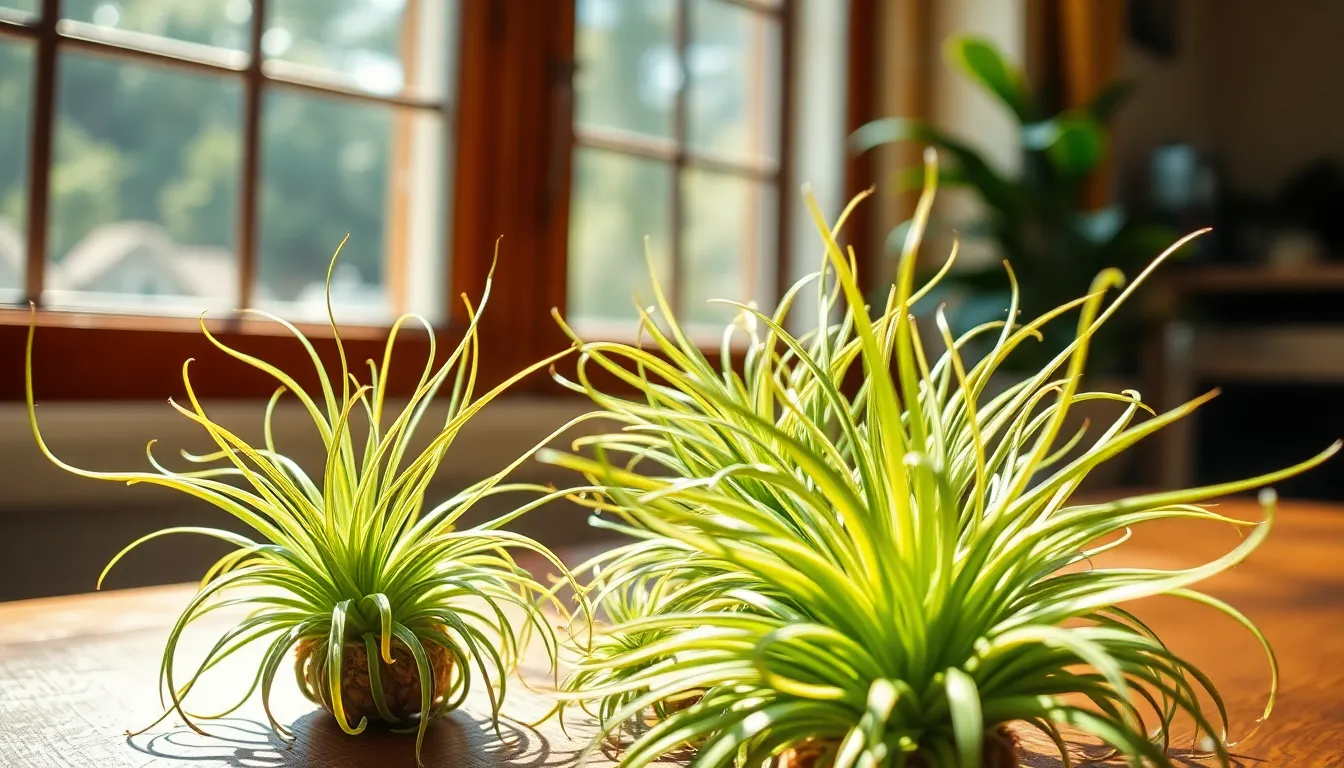
Air plants reproduce naturally through offsets called “pups” that emerge from the base of mature plants. Pups develop into independent plants once they reach one-third to one-half the size of their mother plant.
Removing and Caring for Pups
Separate pups by gently twisting them away from the mother plant when they achieve adequate size. Ensure each pup retains a small portion of the base during removal to maintain viability.
Position newly separated pups in bright, indirectly lit locations with excellent air circulation. Fresh pups require identical care conditions as mature specimens but respond more sensitively to environmental changes.
Apply consistent watering schedules by misting or soaking young plants similarly to established air plants. Monitor environmental humidity and temperature to adjust watering frequency accordingly.
Observe pup development for the first 4-6 weeks after separation to ensure successful establishment. Healthy pups display firm leaf structure and gradual size increases over time.
Creating Optimal Conditions for Growth
Maintain temperature ranges between 50°F and 90°F for optimal air plant propagation and growth. Consistent temperatures within this range promote steady development in both mature plants and newly separated pups.
Provide bright, indirect light exposure using natural sunlight or artificial grow lights when natural illumination proves insufficient. Avoid direct sunlight that can scorch delicate air plant tissues.
Establish humidity levels around 40-60% to support healthy air plant metabolism and growth processes. Higher humidity reduces watering frequency while lower humidity increases misting requirements.
Carry out watering schedules every one to two weeks through misting or soaking methods based on environmental conditions. Dry conditions require more frequent misting while humid environments extend intervals between waterings.
Apply diluted liquid fertilizer formulated specifically for air plants or bromeliads once monthly during spring and summer growing seasons. Fertilization supports robust growth in propagated plants and enhances pup production in mature specimens.
Seasonal Care Adjustments
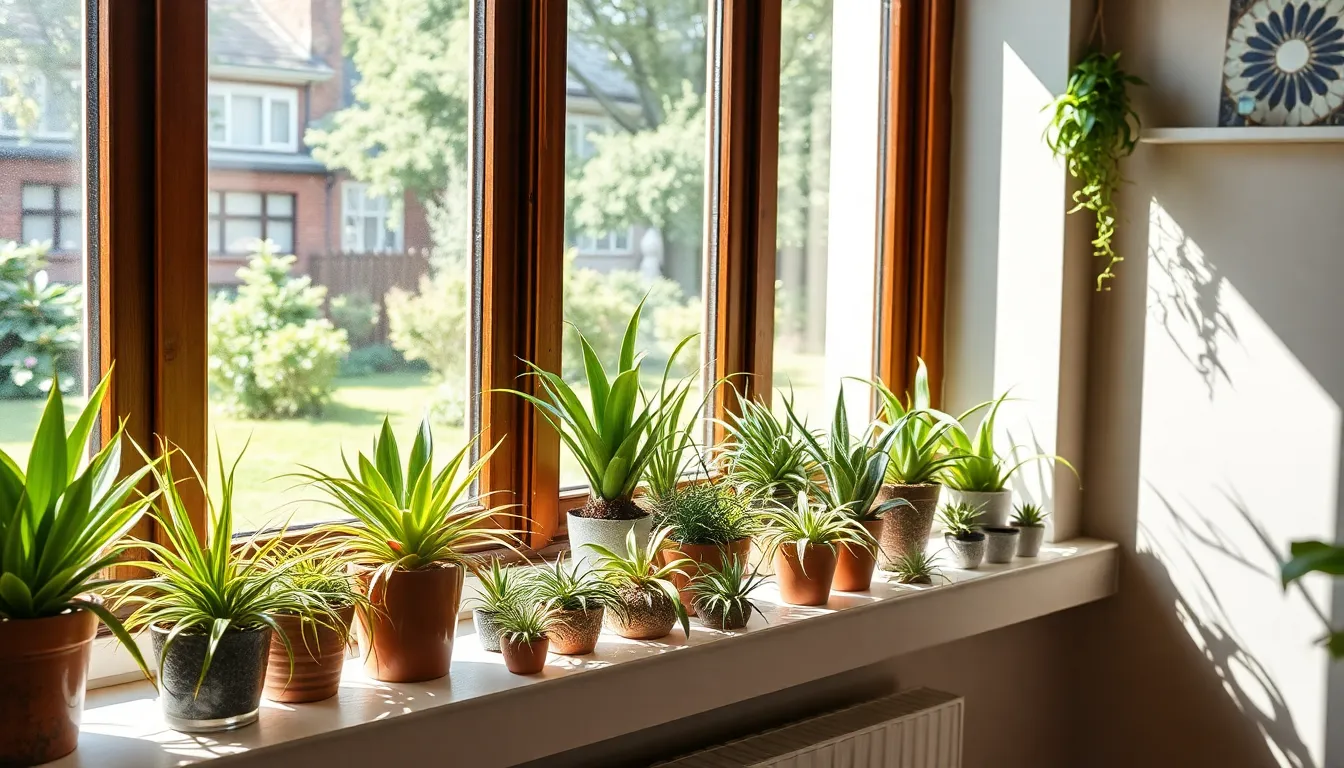
Air plants experience different environmental conditions throughout the year that require exact care modifications. Adjusting our care routine according to seasonal changes helps maintain healthy growth patterns and prevents common issues like dehydration or root rot.
Summer Care Tips
Increased watering frequency becomes essential during summer months when indoor air becomes drier and temperatures rise. We water our air plants more frequently than the standard one to two week schedule to compensate for the rapid moisture loss caused by heat and dry conditions.
Misting weekly provides additional moisture support between regular watering sessions. This supplemental hydration method helps maintain the 40-60% humidity levels that air plants require during peak summer conditions. We focus the mist on the leaf surfaces where specialized scales absorb moisture most effectively.
Air circulation improvements prevent moisture buildup that leads to bacterial or fungal issues in humid summer weather. We position our air plants in areas with gentle airflow from fans or natural breezes while avoiding direct drafts from air conditioning units. Good ventilation ensures plants dry completely within 4 hours after watering.
Winter Care Considerations
Reduced watering schedules accommodate the naturally higher indoor humidity levels during winter months. We decrease watering frequency since plants lose moisture more slowly in cooler temperatures and humid conditions. Overwatering becomes a greater risk when plants cannot process excess moisture efficiently.
Brighter placement locations compensate for the reduced daylight hours and weaker sunlight intensity during winter. We move our air plants closer to east or south-facing windows to maximize their exposure to available natural light. Supplemental grow lights positioned 12-24 inches away provide additional illumination when natural light proves insufficient.
Maintaining humid environments becomes crucial as heating systems create dry indoor air that can desiccate air plants. We place plants in naturally humid areas like bathrooms or group them together to create localized humidity zones. Temperature ranges between 50°F to 90°F remain important even during winter months when heating fluctuations occur.
Troubleshooting Common Air Plant Problems
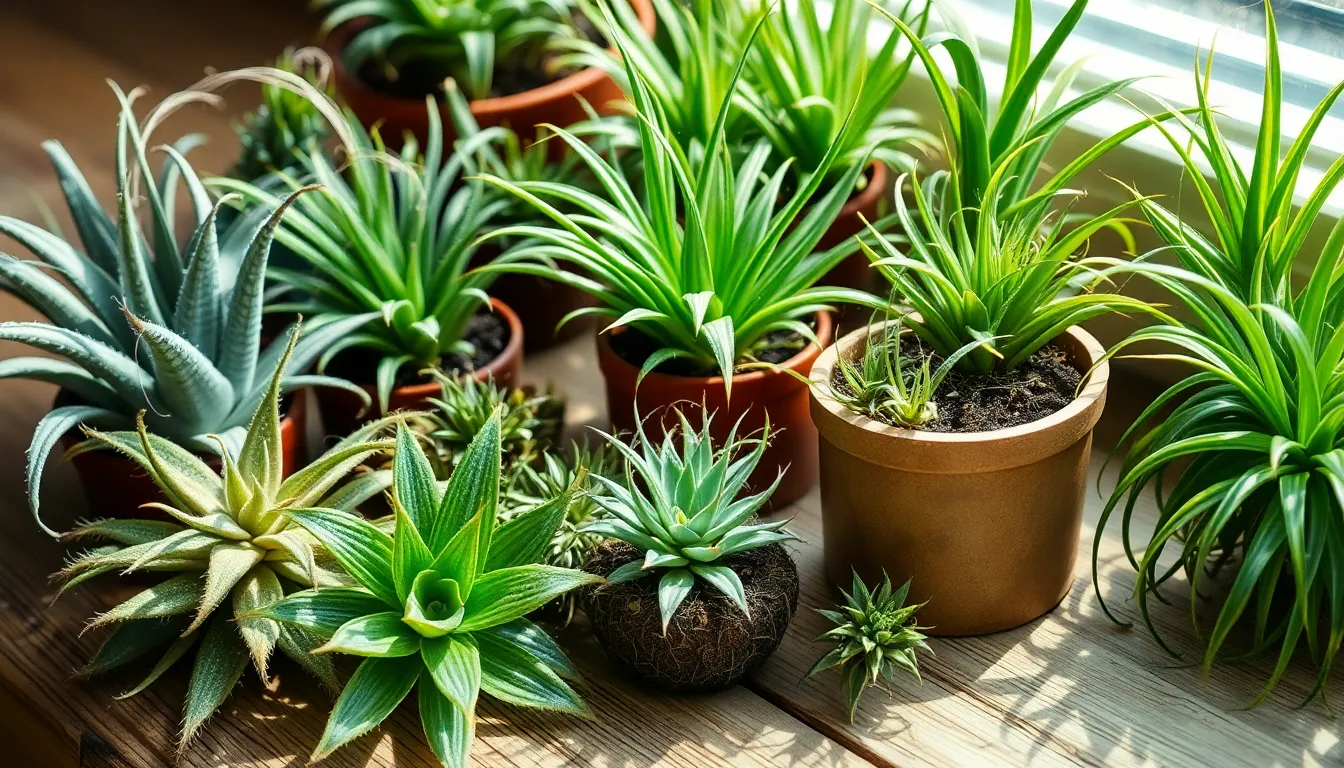
Even experienced plant enthusiasts encounter challenges when caring for air plants. We address the most common issues and provide proven answers to restore your plants to optimal health.
Overwatering Signs and Answers
Rotting or soft leaves indicate excessive moisture exposure in air plants. Base rot appears as dark, mushy tissue that spreads upward through the plant structure. Leaves lose their natural firmness and develop a translucent appearance when overwatering occurs.
Reduce watering frequency immediately once you identify these symptoms. Allow plants to dry completely between watering sessions, extending the drying time to 1-3 hours after each treatment. Remove affected leaves gently using clean hands to prevent bacterial spread. Place overwatered plants in areas with increased air circulation to accelerate moisture evaporation.
Monitor recovery progress by checking leaf texture weekly. Healthy tissue feels firm and maintains its natural color variations. Plants typically recover within 2-3 weeks when proper drying protocols are followed consistently.
Underwatering Symptoms
Dry, wrinkled leaves signal insufficient moisture levels in air plant tissues. Leaf tips curl inward and edges become brittle when dehydration progresses. The natural plumpness of healthy leaves diminishes, creating a shriveled appearance throughout the plant.
Increase misting frequency to 2-3 times per week for immediate relief. Extend soaking duration to 10-15 minutes every week until symptoms improve. Submerge the entire plant except for blooming flowers during these extended soaking sessions.
Create humid microclimates around affected plants using water-filled trays with pebbles. Position plants 2-3 inches above water surfaces to maintain consistent humidity levels of 40-60%. Recovery typically occurs within 1-2 weeks with consistent moisture management.
Brown Tips and Leaf Issues
Brown leaf tips result from multiple stress factors including excessive direct sunlight and watering imbalances. Over-exposure to temperatures above 90°F causes cellular damage that manifests as browning tissue. Chemical buildup from tap water creates similar discoloration patterns.
Adjust lighting conditions by relocating plants to areas receiving bright, indirect sunlight only. Filter harsh afternoon sun using sheer curtains or positioning plants 3-4 feet from south-facing windows. Switch to rainwater or distilled water to eliminate chemical accumulation.
Trim brown portions using clean scissors, cutting at 45-degree angles to promote healing. Remove entire leaves when more than 50% of the surface shows damage. Maintain temperatures between 50°F and 90°F to prevent further stress-related browning.
Pest Problems and Treatment
Spider mites and mealybugs commonly attack weakened air plants in dry indoor environments. Spider mites create fine webbing between leaves and cause stippled yellow damage patterns. Mealybugs appear as white, cotton-like masses concentrated in leaf crevices and growing points.
Isolate infected plants immediately to prevent pest spread to healthy specimens. Rinse affected areas gently using lukewarm water to dislodge visible pests. Apply insecticidal soap answers diluted to half strength every 3-4 days until pest activity ceases.
Increase humidity levels around treated plants to discourage future infestations. Monitor recovery weekly by examining leaf undersides and growing points for pest activity signs. Complete treatment cycles typically require 2-3 weeks of consistent application and monitoring.
Signs of a Healthy vs. Unhealthy Air Plant
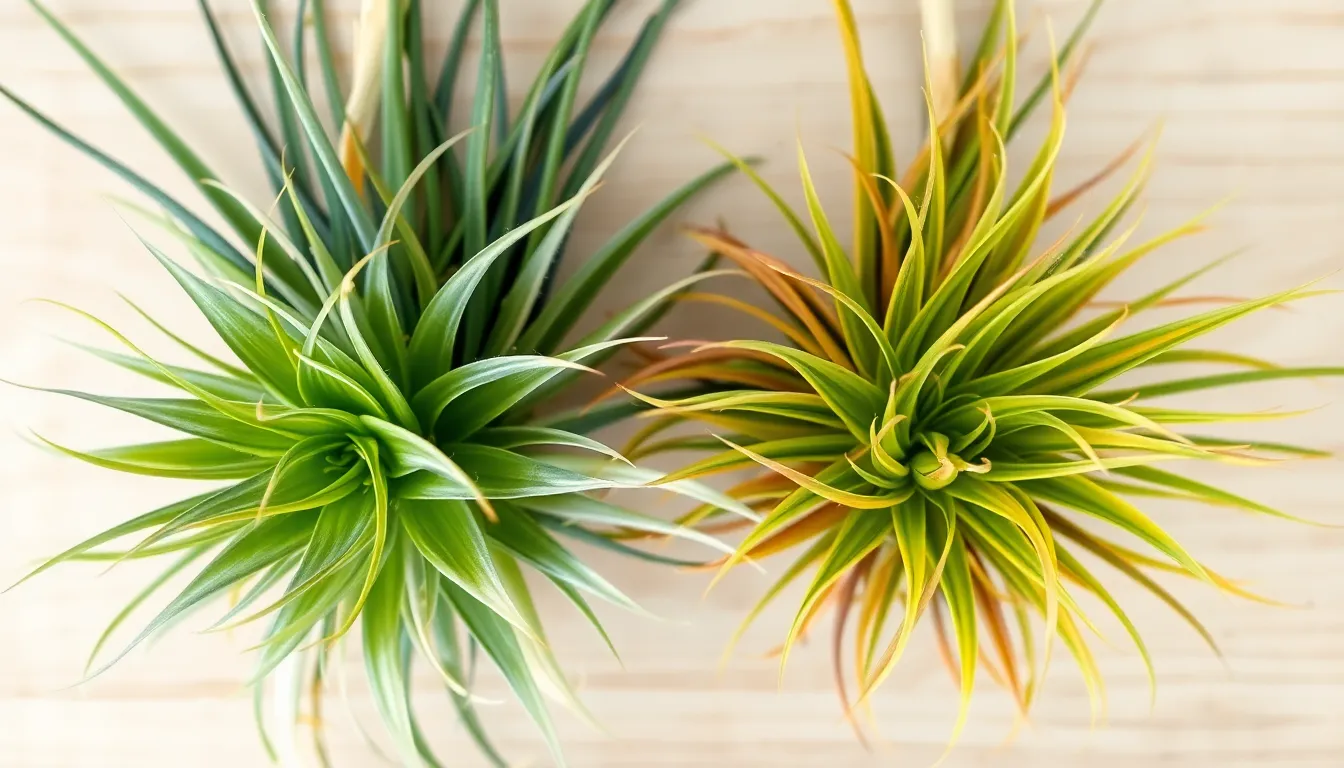
Recognizing the signs of plant health allows us to provide timely care and prevent serious problems from developing. Healthy air plants display firm, plump leaves with vibrant colors ranging from greens to silvers or reds depending on the exact species. Growth patterns indicate vitality through the emergence of new leaves or pups that develop at the base of mature plants.
Upright, sturdy form characterizes plants receiving proper care and environmental conditions. Some species produce visible roots at their base, though this feature varies among different Tillandsia varieties and does not indicate distress when absent. Mature plants demonstrate their health through blooming cycles, as each air plant flowers once during its lifetime before producing new pups.
Identifying Unhealthy Air Plants
Leaves turning brown, yellow, or black signal overwatering, underwatering, or rot development that requires immediate attention. Texture changes become apparent when leaves feel mushy or soft, indicating rot from excess moisture accumulation. Excessive inward curling of leaves typically indicates dehydration that prolonged dry conditions cause.
Stunted growth patterns manifest as plants that show no development or actually shrink in size over time. Advanced rot creates gray or black coloration at the plant base accompanied by foul odors that indicate potentially fatal damage. These symptoms require immediate intervention to prevent complete plant loss.
| Healthy Signs | Unhealthy Signs |
|---|---|
| Firm, plump leaves with vibrant color | Brown, yellow, or black leaves |
| New leaf or pup growth | Mushy, soft leaf texture |
| Upright, sturdy form | Excessive leaf curling inward |
| Visible base roots (species dependent) | No growth or shrinking size |
| Blooming cycle completion | Gray/black base with foul smell |
Monitoring these indicators helps us maintain optimal growing conditions through proper air circulation, lighting, and water management practices. Plants displaying multiple unhealthy signs require immediate care adjustments to prevent permanent damage or death.
Long-Term Maintenance and Care Tips
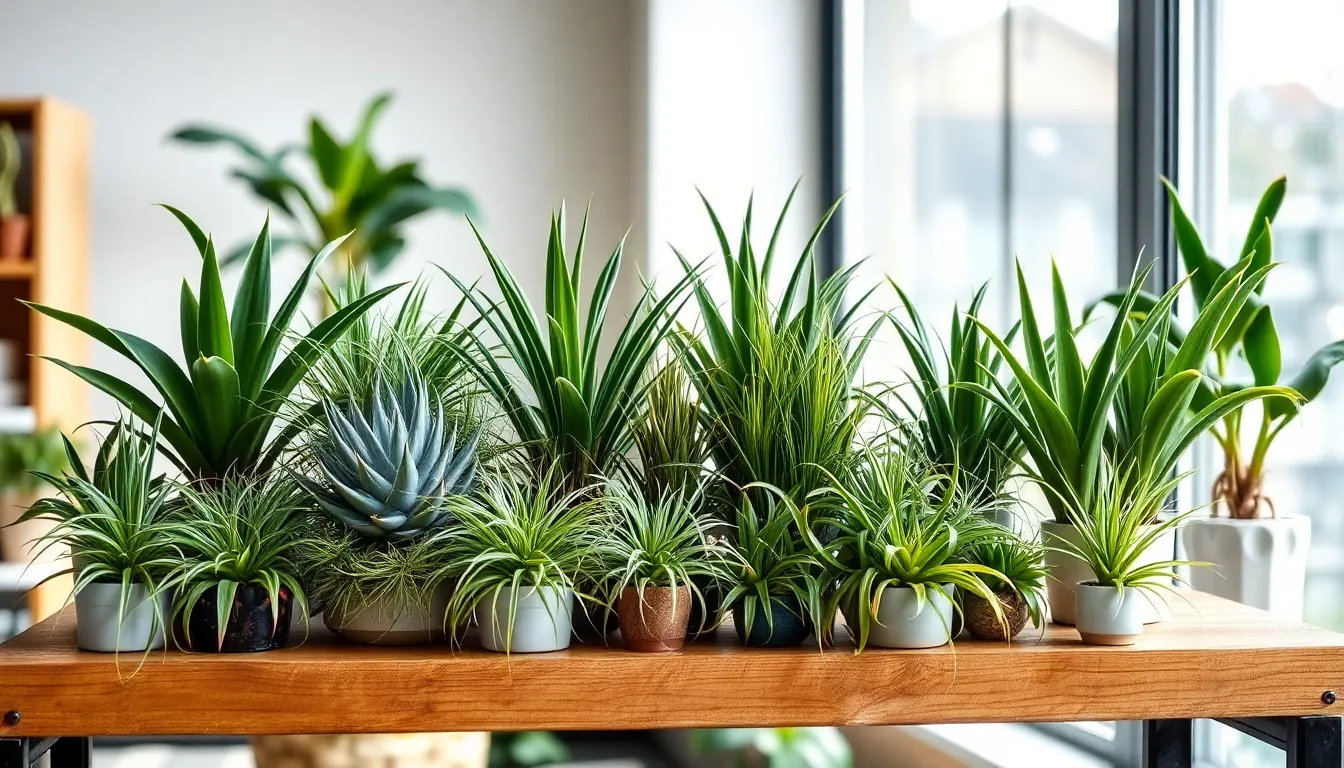
Consistency forms the foundation of successful air plant longevity, requiring us to establish routine care patterns that adapt to plant maturity and environmental changes. Regular maintenance schedules become more critical as plants develop larger root systems and increased moisture requirements over time.
Creating Maintenance Schedules
Monthly inspections allow us to monitor plant health and adjust care routines based on seasonal variations and growth patterns. We examine leaf color changes, measure new growth development, and assess overall plant structure during these evaluations.
Seasonal adjustments require modifying watering frequency and fertilization timing based on temperature fluctuations and humidity levels throughout the year. Summer months demand increased misting frequency up to 3-4 times per week, while winter periods reduce watering to once weekly soaking sessions.
Growth tracking helps us identify when plants require larger display containers or additional support structures as they mature. We document pup development and parent plant expansion to plan for future propagation activities.
Advanced Care Techniques
Deep soaking methods involve submerging mature plants for 30-45 minutes monthly to ensure complete hydration penetration through thicker leaf structures. Large specimens like Tillandsia xerographica benefit from extended soaking periods due to their dense rosette formations.
Fertilizer rotation prevents nutrient buildup by alternating between different diluted liquid fertilizer formulations designed specifically for air plants and bromeliads. We apply fertilizers during spring and summer months at quarter strength concentrations to avoid chemical burn damage.
Air circulation optimization requires positioning mature plants in locations with consistent airflow patterns to prevent moisture accumulation around dense leaf clusters. Ceiling fans or strategically placed desk fans maintain gentle air movement without creating excessive draft conditions.
Aging Plant Management
Leaf pruning involves removing yellowing or browning foliage by gently pulling dead leaves from the base of mature plants to prevent bacterial growth and maintain appearance. We perform this maintenance task monthly or as needed based on individual plant conditions.
Support systems become necessary for large air plants that develop heavy blooming structures or extensive root systems requiring additional stability. Wire frames or mounting hardware provide structural support without restricting natural growth patterns.
Division timing occurs when parent plants produce multiple large pups that compete for resources and space within display arrangements. We separate offsets once they reach one third the size of the parent plant to ensure successful independent growth.
| Maintenance Task | Frequency | Mature Plant Adjustment |
|---|---|---|
| Health Inspection | Monthly | Increase to bi-weekly |
| Deep Soaking | Weekly | Extend to 30-45 minutes |
| Fertilizer Application | Monthly (Spring/Summer) | Rotate formulations |
| Dead Leaf Removal | As needed | Monthly minimum |
| Pup Separation | When 1/3 parent size | Monitor multiple pups |
Environmental monitoring tracks humidity levels, temperature ranges, and light exposure changes that affect mature air plant health over extended periods. Digital hygrometers and thermometers provide accurate readings for optimal growing condition maintenance.
Collection expansion planning considers space requirements and care capacity as air plant collections grow through natural propagation and new acquisitions. We evaluate display options and maintenance time commitments before adding new specimens to existing arrangements.
Conclusion
Air plants offer us an incredible opportunity to bring natural beauty into our homes without the complexity of traditional gardening. We’ve covered everything from basic care requirements to advanced propagation techniques that’ll help your Tillandsia collection thrive for years to come.
The key to success lies in consistency and observation. By establishing regular watering schedules understanding your plants’ seasonal needs and recognizing early warning signs you’ll develop the confidence to expand your collection and experiment with creative displays.
Remember that every air plant journey is unique. What works perfectly in our homes might need slight adjustments in yours based on your exact environment and climate conditions.
With the knowledge you’ve gained here you’re well-equipped to become a successful air plant parent. Start with one or two beginner-friendly varieties and watch as these fascinating plants transform your living space into a vibrant low-maintenance oasis.
Frequently Asked Questions
What are air plants and how do they grow without soil?
Air plants are epiphytic plants from the Tillandsia genus that naturally grow on other plants without being parasitic. They absorb moisture and nutrients through specialized scales on their leaves rather than traditional root systems. With over 500 species, they thrive by clinging to surfaces like tree branches and rocks in their natural habitats across Central and South America.
What are the main advantages of growing air plants?
Air plants offer several benefits for modern plant enthusiasts: they require no soil, can be placed anywhere with proper light, need minimal space, have low maintenance schedules, and are highly drought tolerant. Their versatility makes them perfect decorative elements that can enhance any space while serving as attractive conversation starters.
What are the different types of air plants?
Air plants are categorized into three main types based on appearance and care needs: mesic varieties (prefer higher humidity), xeric varieties (tolerate drier conditions), and intermediate varieties (balanced requirements). Popular beginner-friendly species include Tillandsia ionantha, Tillandsia xerographica, and Tillandsia caput-medusae, each offering unique visual appeal and simple care requirements.
What supplies do I need to care for air plants?
Essential supplies include proper water (rainwater, pond water, or dechlorinated tap water), plant misters and soaking containers for watering, diluted liquid fertilizers designed for air plants or bromeliads, and handling equipment like cotton gloves and soft brushes. These materials ensure optimal growing conditions and protect delicate plant structures during maintenance.
How often should I water my air plants?
Watering frequency depends on the species type and environmental conditions. Xeric varieties need less frequent watering than mesic varieties. Generally, use the soaking method (submerging in water) weekly and mist between soakings. Signs of dehydration include curling leaves and browning tips. Adjust schedules based on seasonal changes and indoor climate factors.
What kind of environment do air plants need?
Air plants thrive in bright, indirect sunlight with temperatures between 50°F to 90°F and humidity levels of 40-60%. They need good air circulation to prevent moisture accumulation and potential rot. Avoid direct sunlight and temperature fluctuations. Open display methods that promote air exchange are recommended for optimal health.
How do I fertilize air plants?
Feed air plants monthly during spring and summer using diluted liquid fertilizers specifically designed for air plants or bromeliads. Standard houseplant fertilizers can harm them. Reduce fertilization frequency in fall and winter. Apply through misting or soaking methods, ensuring proper dilution to prevent nutrient burn. Monitor plants carefully to maintain health.
What are creative ways to display air plants?
Air plants offer versatile display options including hanging arrangements using wire or string, frame-mounted displays for modern interiors, and mounted arrangements on wooden boards or slate tiles. Terrarium displays in glass containers create miniature ecosystems. Always use open-top designs to prevent moisture buildup and ensure proper air circulation.
How do air plants reproduce and can I propagate them?
Air plants reproduce naturally through offsets called “pups” that develop into independent plants. Once pups reach adequate size, they can be separated from the parent plant and cared for like mature plants. Maintain consistent temperature, light, humidity, and watering conditions for successful propagation and healthy growth of new plants.
How should I adjust air plant care seasonally?
In summer, increase watering frequency and misting while ensuring good air circulation to prevent moisture buildup. During winter, reduce watering due to higher indoor humidity, provide brighter placement to compensate for reduced daylight, and create humid environments to counteract drying heating systems. Seasonal adjustments prevent dehydration and root rot.
What are common air plant problems and solutions?
Common issues include overwatering (rotting leaves – reduce watering and improve circulation), underwatering (increase misting and soaking), brown tips from stress (adjust lighting and watering), and pest infestations like spider mites or mealybugs (treat with appropriate methods while maintaining humidity). Monitor plants regularly and adjust care promptly.
How can I tell if my air plant is healthy?
Healthy air plants have firm, plump leaves with vibrant colors, show new growth through leaves or pups, maintain upright form, and may produce visible roots or blooms. Unhealthy plants display brown, yellow, or black leaves, mushy textures, excessive curling, stunted growth, and foul odors. Multiple unhealthy signs require immediate care adjustments.

